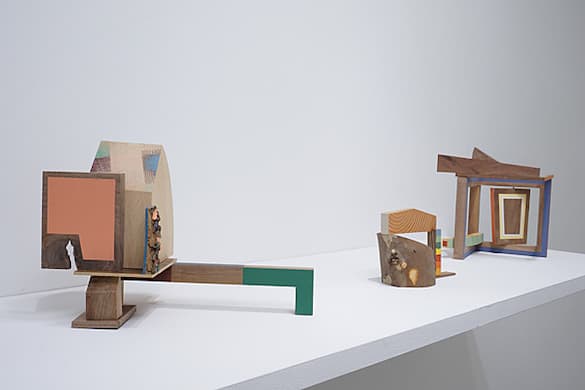At McKenzie Fine Art, a Focus on Process
Austin Ballard, Ron Janowich, Jim Osman, and Raymond Saá are the featured artists in ‘Step by Step,’ and it’s a testament to the gallery’s curatorial eye that four very individual talents come off like peas in a pod.

“Step by Step,” an elegantly mounted exhibition at McKenzie Fine Art, concerns itself with art-making as a form of accretion, a process in which rigorous and often labor-intensive procedures allow for organic expressions of form. Austin Ballard, Ron Janowich, Jim Osman, and Raymond Saá are the featured artists, and it’s a testament to the consistency of the gallery’s curatorial eye that four very individual talents come off like peas in a pod.
Repetition figures into the work, as does flexibility of purpose. Craft, in all instances, is impeccably contrived and, in the end, eccentric in configuration. Wood, clay, thread, graphite, paint, and rattan are layered, twisted, bent, incised, questioned, and choreographed. There’s a meditative aspect to the pieces on display — a deliberate emphasis on process tends to do that — as well as a sense of humor. Messrs. Ballard and Osman, in that regard, are especially droll.
Mr. Ballard’s basic structural unit is rattan or, rather, irregular patches of the stuff. He uses them to build flexing biomorphic effigies, distant cousins of Umberto Boccioni’s “Unique Forms of Continuity in Space” (1913) and very much in the Chinese tradition of gongshi, better known in the West as Scholar’s Rocks.
With surfaces dotted by colors seemingly culled from a package of Bazooka bubble gum, Mr. Ballard’s sculptures embody and then still gestures of an extreme sort — imagine the Tasmanian Devil put on pause in mid-torque. Do you want tensile point-and-counterpoint? Mr. Ballard supplies it with uncanny aplomb.
Mr. Saá’s collages are recognizably dependent on precedent — in specific, Matisse’s late efforts in papier colle. Utilizing gouache, paper, and the sharpest of X-acto knives, he paints, cuts, and, with the tidiest of stitchery, reconfigures myriad sheets of paper. The work’s relationship with gravity is a bit odd: Each piece is “top down,” almost as if it were set out on a washing line to dry.
The best of Mr. Saá’s pieces confine themselves to variations on blue and white, the starkness of hue and value doing much to clarify the contours of each shape. When he employs a fleshy array of pinks, yellows, and oranges, the constructive aspect of the work is downplayed and the work loses definition.
Mr. Janowich renders his mandala-like abstractions through silverpoint, an ages-old method of drawing in which a filament of wire is applied to a prepared surface. In this case, each sheet of paper has been coated with a thin layer of clay, into which the nib of the stylus etches a fine line.
Mr. Janowich works with gridded patterns that resemble weaving and does so with a precision that, for all its attention to minutiae, abjures the obsessive. A fine coat of graphite powder is applied over the resulting compositions, endowing each piece with a fetching metallic sheen. Nose up to Mr. Janowich’s works-on-paper; their attractions are best considered from inches away.
Equipoise achieved through humble means is Mr. Osman’s forte. Working with lumberyard cast-offs, along with the stray oddment of bark or tree limb, he imagines what might happen if architecture could manage to pirouette or, in pieces like “Wave” and “Eave” (both 2022), walk the tightrope. A deep-seated knowledge of carpentry and, along with it, mathematics figure into his stage-like constructions, but so, too, does whimsy.
Color is key to Mr. Osman’s off-kilter lyricism, his palette being a curious amalgam of baby’s nursery and the industrial warehouse. Applied selectively, his off-topic colors underscore the work’s underlying geometry or, in the case of “Court” (2022), amplify the material’s natural grain. The best of the bunch is “Walk” (2023), wherein a sign-like placard is supported by an armature that is something between an onion, an umbrella, and a folding fan. It’s at quixotic moments like these that Mr. Osman establishes himself as a poet in the woodpile.

